|
|
|
Sort Order |
|
|
|
Items / Page
|
|
|
|
|
|
|
| Srl | Item |
| 1 |
ID:
182961
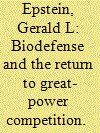

|
|
|
|
|
| Summary/Abstract |
The 2017 US National Security Strategy asserts that, “after being dismissed as a phenomenon of an earlier century, great power competition returned,” pointing to actions that Russia and China have taken to reassert their influence and attempt to change the international order. Such a shift has implications for biodefense. It suggests an increased likelihood of the development and potential use of biological weapons by states, which had been downplayed by those who have been more concerned about non-state biological-weapons programs. State program access to expertise, facilities, and resources implies a greater level of technological sophistication than would typically be credited to non-state actors, influencing the requirements for national biodefense programs to detect, characterize, respond, to, and attribute a biological attack. States also could have missions for biological weapons that differ from those intended by terrorists.
|
|
|
|
|
|
|
|
|
|
|
|
|
|
|
|
| 2 |
ID:
182966


|
|
|
|
|
| Summary/Abstract |
The 1993 Chemical Weapons Convention (CWC) and the 1972 Biological and Toxin Weapons Convention (BWC) are key components of the international arms-control landscape. Yet the two conventions differ widely, particularly in the ways that are available to treaty parties to resolve any questions about compliance with the treaties. Both contain language concerning consultation and cooperation, but the CWC also has extensive procedures available to investigate allegations of noncompliance. This article reviews these differences in the conventions and explains, in part, how and why they came about. The Organisation for the Prohibition of Chemical Weapons (OPCW) has engaged in several consultations regarding compliance issues, but the OPCW publishes virtually nothing about the topics of the consultations or their frequency, findings, or conclusions. An exception, perhaps, is the OPCW’s work regarding Syrian use of chemical weapons (CW). Moreover, thus far, no treaty party has called for a challenge inspection to officially investigate perhaps the most serious allegations of treaty violations: Syrian and Russian alleged use of CW. The BWC states parties conducted one formal consultation raised by Cuba, alleging that the United States dropped biological agents on the island nation from airplanes to cause an animal epidemic. The consultation reached no official conclusion. The article goes on to praise the work of Raymond Zilinskas debunking the allegations through a careful scientific review of the Cuban claims. The article discusses the consequences of secrecy surrounding the CWC consultation process and laments that the BWC does not have the institutional capacity to carry on the type of analysis that Zilinskas undertook discrediting the Cuban allegations.
|
|
|
|
|
|
|
|
|
|
|
|
|
|
|
|
| 3 |
ID:
182955
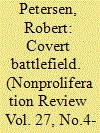

|
|
|
|
|
| Summary/Abstract |
During World War II, the Polish resistance movement used chemical and biological weapons (CBW) against the Third Reich. The use of CBW against the Third Reich most likely originated in a secret Polish biological-weapons program, which existed in the 1930s and went underground after the September 1939 German invasion. Between 1940 and 1942, a unit of the Polish resistance movement named WKZO (Wielkopolskie Kierownictwo Związku Odwetu—the Greater Poland Leadership of the Union of Retaliation) conducted CBW sabotage in the German-annexed area Reichsgau Wartheland and its main city Posen (today’s Poznań). By investigating the use of CBW by the WKZO until its destruction in 1942, it is possible to demonstrate how these weapons were made and used. The article also describes the German reaction, including what defensive measures the German high command took to meet the threat of CBW.
|
|
|
|
|
|
|
|
|
|
|
|
|
|
|
|
| 4 |
ID:
182960
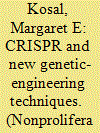

|
|
|
|
|
| Summary/Abstract |
This article explores the potential for new biotechnologically enabled weapons to compete with nuclear weapons in the context of strategic stability, assesses how such new technologies may affect assumptions in traditional strategic-stability models when applied to such scenarios, and how changing capabilities and adversaries may shape approaches to nonproliferation, verification, and monitoring. Among the most recent additions to the genome-editing arsenal is CRISPR (clustered regularly interspaced short palindromic repeats), a bacteria-derived system that is among the simplest genome-editing tools. The CRISPR-Cas9 system—and emerging variants of the system—enables unprecedented control and ease when editing the genome. With parallels to remote “command and control” of the genome, this aspect makes the technology different from earlier gene-editing methods. This article furthers the scholarly work on the biosecurity implications of CRISPR, gene editing, and broader issues of biotechnology by addressing these emerging life-science technologies in the context of nuclear strategic stability and implications for balance of power, nonproliferation, and international security.
|
|
|
|
|
|
|
|
|
|
|
|
|
|
|
|
| 5 |
ID:
182965
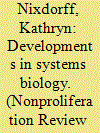

|
|
|
|
|
| Summary/Abstract |
Biological processes occur within complex, vital physiological systems. Systems biology seeks to understand how physiological systems function as a whole, integrating information about interactions in a biological system through computer-assisted modeling, aiming to identify relationships not found within individual biological units. Coupled with advances in the life sciences and computing power, this research is yielding an enormous amount of information about specific targets of vital physiological processes, and enabling predictions about how these targets may respond to a disturbance or change in signaling. This information can be greatly beneficial in treating complex diseases. It also has extended the spectrum of potential threat agents to include bioregulators, which to a great extent regulate the functioning of the nervous, endocrine, and immune systems. There is potential for misuse of the knowledge gained from these studies, and improved methods of targeted delivery of biochemicals make them more feasible weapons agents. Moreover, biochemical security concerns in systems biology are embedded within the larger domain of cyberbiosecurity. There remains a need for proactive approaches to the formulation of biochemical-security-oversight policy that would encompass developments at this interface of the life sciences and information technology.
|
|
|
|
|
|
|
|
|
|
|
|
|
|
|
|
| 6 |
ID:
182970
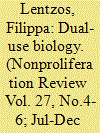

|
|
|
|
|
| Summary/Abstract |
At a time of heightened concern about potential future biological-weapons threats, this article considers how the international community can use the Biological and Toxin Weapons Convention framework to strengthen compliance monitoring of rapidly increasing dual-use capacities around the globe. It presents three conceptual layers within the treaty regime which states can draw from to inform their compliance judgments: one legally binding, one politically binding, and one wholly voluntary. The article outlines how these were established and how they have been used so far, and argues for an incremental, inclusive, practical, and forward-looking approach to evolving these structures to better manage perceptions of the intent behind dual-use capacities, and to further trust between states.
|
|
|
|
|
|
|
|
|
|
|
|
|
|
|
|
| 7 |
ID:
182973
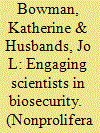

|
|
|
|
|
| Summary/Abstract |
Major efforts to engage scientists in issues of biosecurity in the United States and internationally began in the early 2000s in response to growing concerns about terrorists using weapons of mass destruction and the mailing of anthrax-laced letters in October 2001. This article draws on the literature about the “science of science communication,” including research on framing, to examine the strategies used to try to raise awareness and create support for policies and practices to address public concerns about biosecurity issues within scientific communities. Engagement strategies framed as an inherent part of the broader social responsibilities of the scientific community have shown the promise of being more effective than those framed in terms of legal and regulatory requirements and an emphasis on security alone. The article draws on the case of the InterAcademy Partnership (IAP), the global network of academies of science and medicine, and its relationship with the 1972 Biological and Toxin Weapons Convention (BWC), with additional examples from other national and international scientific organizations.
|
|
|
|
|
|
|
|
|
|
|
|
|
|
|
|
| 8 |
ID:
182963
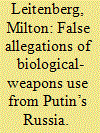

|
|
|
|
|
| Summary/Abstract |
From 1949 until 1988, the Soviet Union conducted a nearly continuous campaign of false allegations of biological-weapon (BW) use by the United States. In 1995, senior Russian military officials revived this pattern of false allegations, which continues to the present day. Russian officials amplified the campaign after the US government funded the transformation of former Soviet BW facilities in the Commonwealth of Independent States under the Nunn–Lugar program. The outbreak of the COVID-19 pandemic in China in January 2020 prompted a very greatly expanded Russian-government BW-related disinformation effort. This paper aims to present a reasonably comprehensive account of these activities and to assess their significance. The Russian government under President Vladimir Putin has demonstrated open disdain for both the Biological and Toxin Weapons Convention and the Chemical Weapons Convention.
|
|
|
|
|
|
|
|
|
|
|
|
|
|
|
|
| 9 |
ID:
182959
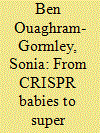

|
|
|
|
|
| Summary/Abstract |
The gene-editing technique CRISPR—clustered regularly interspaced short palindromic repeats—is often depicted as a security threat because it could theoretically allow scientists or amateurs to edit the genome of a variety of organisms and potentially cause harm to humans, plants, and animals. The recent use of CRISPR by Chinese scientist He Jiankui to edit the genome of viable embryos, which resulted in the birth of twin girls, has exacerbated those fears. This article reviews the timeline of the CRISPR-babies experiment, highlights the challenges that contributed to the experiment's failure, and evaluates the risks of CRISPR's use for malevolent purposes. It concludes that although the potential for abuse is great, the technical obstacles are still too significant to allow successful modification that would threaten security.
|
|
|
|
|
|
|
|
|
|
|
|
|
|
|
|
| 10 |
ID:
182952
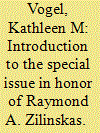

|
|
|
|
|
| Summary/Abstract |
I first met Ray Zilinskas in 1998, when I was fresh out of graduate school, a young and impressionable postdoc in the Chemical and Biological Weapons Nonproliferation Program at the Center for Nonproliferation Studies, Monterey Institute of International Studies, as it was then known. When we were first introduced, I was a bit intimidated, as he was a well-known former bioweapons weapons inspector in Iraq, but Ray was always gracious and kind. He had a heart for students and young scholars, always welcoming newcomers into the “Monterey Mafia.”
|
|
|
|
|
|
|
|
|
|
|
|
|
|
|
|
| 11 |
ID:
182962
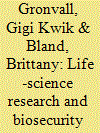

|
|
|
|
|
| Summary/Abstract |
This article examines the current state of the life sciences in the Russian Federation, which has potential health-security and biosecurity implications. Research involving advanced biotechnologies present opportunities for public-health advancement, but their dual-use capabilities raise biosecurity concerns that carry global economic and security implications. While experts have raised such concerns about possible Russian misuse of biotechnologies, Russia is not a top-tier nation for life sciences research, by many metrics. A better understanding of the current landscape of biotechnology and life-science research and investment in the Russian Federation will help to identify potential areas of concern and opportunities for international scientific engagement. This work builds on the substantial legacy of Raymond A. Zilinskas in his work to describe and analyze biodefense and biosecurity concerns in the Russian Federation and the Soviet Union.
|
|
|
|
|
|
|
|
|
|
|
|
|
|
|
|
| 12 |
ID:
182954
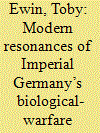

|
|
|
|
|
| Summary/Abstract |
This article summarizes published and archival information about Imperial Germany’s attempts to infect draft animals in some Allied and neutral countries with anthrax and glanders during World War I. It casts doubt on claims that the Isle of Man was among the places affected. It considers the extent to which contemporary terrorist activity more closely resembles German biological sabotage plots than it does most modern state weapons-of-mass-destruction programs.
|
|
|
|
|
|
|
|
|
|
|
|
|
|
|
|
| 13 |
ID:
182968
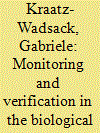

|
|
|
|
|
| Summary/Abstract |
This article provides a brief overview of the ongoing monitoring and verification (OMV) regime in Iraq in the biological-weapons area. As an integral part of the formal ceasefire arrangement in 1991, the United Nations Security Council established an international verification regime encompassing nuclear, biological, and chemical weapons and some ballistic missiles. The verification regime was built on two mutually supportive pillars. One pillar related to disarmament validation, i.e., verifying that all prohibited weapons, facilities, and related items and certain ballistic missiles in Iraq were destroyed or rendered harmless, and all past weapons-of-mass-destruction (WMD) activities had ceased. The second pillar was ongoing monitoring to continuously verify that non-proscribed activities were not being diverted to reconstitute WMD programs. Biological-weapons disarmament and OMV in Iraq provide an example of an effective system that may serve as a reference point for future efforts.
|
|
|
|
|
|
|
|
|
|
|
|
|
|
|
|
| 14 |
ID:
182953
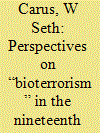

|
|
|
|
|
| Summary/Abstract |
The concept of “biological terrorism” predates the provenance of the term. Prominent anarchist intellectuals as well as sensationalist journalists alike promulgated the concept of deliberate disease during the last half of the nineteenth century. However, their published works do not reflect an accurate understanding of the biological sciences. In fact, the most accurate writings on disease as a weapon came not from anarchists or journalists, but from science-fiction writers.
|
|
|
|
|
|
|
|
|
|
|
|
|
|
|
|
| 15 |
ID:
182969
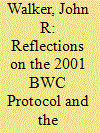

|
|
|
|
|
| Summary/Abstract |
The history of the 1972 Biological and Toxin Weapons Convention (BWC) shows that efforts to make its compliance provisions more effective have invariably fallen short. The high point of these efforts came during the 1995–2001 verification-protocol negotiations in the Ad Hoc Group (AHG). Despite solid preparation by the 1992–93 verification experts’ meetings, the AHG failed to reach agreement on a Protocol. The challenges of devising effective verification measures were then, and remain now, considerable: a combination of complex scientific, technological, diplomatic, and legal obstacles proved insurmountable. Despite the passage of time, some states parties continue to call for the AHG’s resumption, but many of those doing so have forgotten the challenges and that their own positions in the 1990s were instrumental in the AHG’s failure. This does not augur well for future efforts to strengthen the BWC at its Ninth Review Conference.
|
|
|
|
|
|
|
|
|
|
|
|
|
|
|
|
| 16 |
ID:
182957


|
|
|
|
|
| Summary/Abstract |
The Women’s International League for Peace and Freedom (WILPF) is the oldest active women’s peace organization in the world. Although their overall aim is the abolition of all war, from the outset they voiced particular opposition to chemical warfare. Later, this became a call against both chemical and biological warfare (CBW). This article draws on archival documents to trace this history, concentrating on the early days of WILPF and then on revived interest in the topic during the late 1960s and early 1970s. While early WILPF did not define CBW as an issue with any special gendered relevance for women, the historical record shows WILPF placed emphasis on its leading role in organizing opposition. It also shows a consistency of approach, WILPF often acting in an educational capacity as an informer of public opinion about the horrors of CBW. Over time, WILPF’s role changed in that the leaders of the key campaigns against CBW came to regard their role as distinct from those of scientists.
|
|
|
|
|
|
|
|
|
|
|
|
|
|
|
|
| 17 |
ID:
182971


|
|
|
|
|
| Summary/Abstract |
Concerns that biological weapons will be used has focused attention on the need to develop a capability to independently investigate any allegation of use. The United Nations Secretary-General’s Mechanism is one such tool, and efforts to revitalize and strengthen it have acknowledged a wide range of technical difficulties to overcome. This article emphasizes another aspect of the investigatory process: communicating the findings of an investigation. The article frames the investigation report as more than a technical recounting of what the investigators did and found, regarding it instead as the means by which the policy-making audience “makes sense” of the allegation. Drawing on literatures associated with science policy and “boundary objects,” the article reflects on the guidance provided thus far and suggests there has been an implicit move toward seeing the reports as “boundary documents.” The suggestion made here is that this implicit recognition should be now made explicit so that the critical position of the report is better appreciated. This has implications for the training of rostered experts.
|
|
|
|
|
|
|
|
|
|
|
|
|
|
|
|
| 18 |
ID:
182964
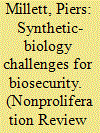

|
|
|
|
|
| Summary/Abstract |
Although synthetic biology and biological engineering are often portrayed as emerging disciplines, there is over a decade of experience in their interactions with biosecurity. The International Genetically Engineered Machine competition (iGEM) brings together nearly 6000 students on multidisciplinary teams to engineer biology following synthetic biology’s “design, build, test, and learn” cycle. During its fifteen-year existence, iGEM has been affected by biosecurity and in turn has affected it. This article describes four specific case studies at iGEM, highlighting their implications for biosecurity, and proposes ways to improve relevant biosecurity procedures and practices. It showcases how embracing engineering approaches and principles can help to structure efforts to strengthen biosecurity.
|
|
|
|
|
|
|
|
|
|
|
|
|
|
|
|
| 19 |
ID:
182972


|
|
|
|
|
| Summary/Abstract |
This article explores emerging science and technology advances relevant to the 1972 Biological and Toxin Weapons Convention (BWC), and existing and needed frameworks for their identification, risk assessment, and evaluation of benefit. Threats from biological weapons continue to be a major concern as state and non-state actors have developed, used, or expressed interest in these types of weapons. International nonproliferation instruments and related efforts in health security, specifically the 2005 International Health Regulations and the 2014 Global Health Security Agenda, recognize deliberate biological incidents as one of three threats to address (the others being natural and accidental biological events). To date, these instruments and their subsequent regional and national-level implementation efforts focus primarily on pathogens and toxins as biological threat agents. Unlike the other instruments, the BWC focuses on preventing the diversion of peaceful and prophylactic uses of biology to the development, production, stockpiling, or dissemination and delivery of biological weapons. Accordingly, the BWC recognizes the importance of scientific and technological advances in enabling different actors to develop or disseminate biological agents, altering the risk profile of deliberate biological threats. To identify and discuss advances that may affect implementation of the BWC, the US National Academy of Sciences and the BWC Implementation Support Unit conducted or sponsored several activities to explore science and technologies that may be most relevant to the BWC. However, the biotechnology landscape continues to change drastically, expanding the focus of security risks beyond pathogens and toxins to include other biological data and materials, such as synthetic organisms. Factors promoting the development of biotechnology capabilities include new funders and funding models, practitioners from other disciplines leveraging the tools of biology, new nations investing in the biological sciences, and research leveraging advances in engineering, computer, data, materials, physical, and chemical sciences. These advances may reveal new capabilities that significantly alter biological nonproliferation efforts, including both new security threats and benefits to society.
|
|
|
|
|
|
|
|
|
|
|
|
|
|
|
|
| 20 |
ID:
182956


|
|
|
|
|
| Summary/Abstract |
Between 1940 and the late 1950s, the United Kingdom had a limited biological program to provide a retaliatory capability should UK forces be attacked using biological warfare (BW). Aspects of BW defense have been investigated from 1940 up to the present day. Techniques, processes, and equipment used within biological research programs are recognized to have dual-use applications; aerobiology is one such dual-use area. Research during these offensive and defensive eras of the UK BW research program has contributed to aerobiological science, leading to a number of positive changes in some areas, including laboratory safety; understanding of infection by the aerosol route; and survival, detection, and identification of airborne pathogens. This article will discuss the historical contributions made to aerobiology science, the global contemporary legislation that governs dual-use research, and a modern case study based upon this type of investigation. The article will contribute to our understanding of the dual-use aspects of a BW program.
|
|
|
|
|
|
|
|
|
|
|
|
|
|
|
|
|
|
|
|
|